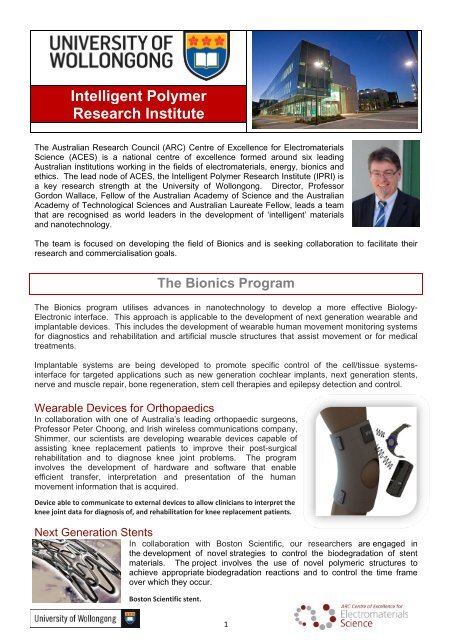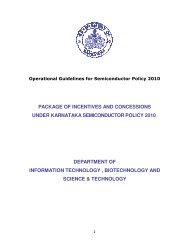Intelligent Polymer Research Institute
Intelligent Polymer Research Institute
Intelligent Polymer Research Institute
You also want an ePaper? Increase the reach of your titles
YUMPU automatically turns print PDFs into web optimized ePapers that Google loves.
<strong>Intelligent</strong> <strong>Polymer</strong><strong>Research</strong> <strong>Institute</strong>The Australian <strong>Research</strong> Council (ARC) Centre of Excellence for ElectromaterialsScience (ACES) is a national centre of excellence formed around six leadingAustralian institutions working in the fields of electromaterials, energy, bionics andethics. The lead node of ACES, the <strong>Intelligent</strong> <strong>Polymer</strong> <strong>Research</strong> <strong>Institute</strong> (IPRI) isa key research strength at the University of Wollongong. Director, ProfessorGordon Wallace, Fellow of the Australian Academy of Science and the AustralianAcademy of Technological Sciences and Australian Laureate Fellow, leads a teamthat are recognised as world leaders in the development of ‘intelligent’ materialsand nanotechnology.The team is focused on developing the field of Bionics and is seeking collaboration to facilitate theirresearch and commercialisation goals.The Bionics ProgramThe Bionics program utilises advances in nanotechnology to develop a more effective Biology-Electronic interface. This approach is applicable to the development of next generation wearable andimplantable devices. This includes the development of wearable human movement monitoring systemsfor diagnostics and rehabilitation and artificial muscle structures that assist movement or for medicaltreatments.Implantable systems are being developed to promote specific control of the cell/tissue systemsinterfacefor targeted applications such as new generation cochlear implants, next generation stents,nerve and muscle repair, bone regeneration, stem cell therapies and epilepsy detection and control.Wearable Devices for OrthopaedicsIn collaboration with one of Australia’s leading orthopaedic surgeons,Professor Peter Choong, and Irish wireless communications company,Shimmer, our scientists are developing wearable devices capable ofassisting knee replacement patients to improve their post-surgicalrehabilitation and to diagnose knee joint problems. The programinvolves the development of hardware and software that enableefficient transfer, interpretation and presentation of the humanmovement information that is acquired.Device able to communicate to external devices to allow clinicians to interpret theknee joint data for diagnosis of, and rehabilitation for knee replacement patients.Next Generation StentsIn collaboration with Boston Scientific, our researchers are engaged inthe development of novel strategies to control the biodegradation of stentmaterials. The project involves the use of novel polymeric structures toachieve appropriate biodegradation reactions and to control the time frameover which they occur.Boston Scientific stent.1
Artificial MusclesWe have developed polymer-based artificial muscles capable ofproducing significant movement at impressive speed and now seekto develop new polymer fibre constructions to improve theefficiency of the actuators so they can mimic human muscle.These wearable structures will be utilised in prosthetic devices toassist human movement (e.g. rehabilitation glove) and for medicaltreatments (e.g. lymphoedema sleeve). Biocompatible actuatorsalso have use in steerable cochlear implants. In a recentbreakthrough we have demonstrated very large and fast rotationaltype artificial muscles based on carbon nanotubes that may oneday be used to propel micro-bots (Science 334 (2011): 494).Futuristic “micro‐bot” powered by a twisted carbon nanotube yarn torsionalmuscle (Foroughi et al., Science 334 (2011) 494).Nerve and Muscle RegenerationDamaged nerves and spinal cord cause considerable disability tomany people around the world. The integrity of neurons can bemaintained and regenerative re-sprouting achieved throughdelivery of electrical charge using new polymer basedtechnologies. Similar platforms can be used to facilitate musclecell development. Current research is aimed at integrating thesematerials into 3D implants for nerve and muscle regeneration.Fluorescent microscopy images (scale 50 μm) demonstrate that axonal(green) growth and Schwann cell (blue) migration follow the path ofembedded polymer fibres on both stimulated and unstimulated scaffolds.Epilepsy Detection & Control<strong>Polymer</strong> structures capable of providing triggered in vivo drugdelivery systems will greatly impact neural disorders. Delivereddirectly into the brain at the site of seizure focus, these novelcontrolled release systems will reduce the quantity of toxicsubstances in the body and improve patient outcome. Conductedin collaboration with Professor Mark Cook, a neurologist and Chairof Medicine at St Vincent’s Hospital Melbourne, the possibility ofcoupling this release to epilepsy-related brain signals, is at thestage of preclinical trials.Electrospun biodegradable polymer mats containing anti‐epilepsy drugs forsurgical implantation and long term slow release in vivo.Bone RegenerationUsing customised three-dimensional (3D) printing and bio inkformulations, our scientists, in collaboration with Professor PeterChoong, Head of Department of Surgery and Professor ofOrthopaedics at St Vincent’s Hospital Melbourne, are developingstructures targeted at bone regeneration. This involvesoptimisation of the polymer composition with control over themicro- and nano- structure during fabrication.The integration of cells in a fibrous bone matrix.2
Underlying & New Capacities at IPRIUnderlying these technologies is clearly the internationally recognised strength of designing,synthesising, characterising, modelling and fabricating innovative electromaterials. Additionally, withthe input of more than $50 million in government support over the past 5 years, IPRI researchers canboast exceptional facilities, further enabling their core business but also allowing them to investigateproduction scale-up, rapid prototyping and fabrication of devices for input into clinical or experimentaltrials.Each of the above clinical applications requires the following:• Nanoscale Characterisation: The continued optimisation ofnanostructured materials for bionics requires an understanding ofthe biological entities encountered at the cellular-device interface.We have initiated an ambitious program to develop nanoscaleprobing techniques such as Bio-Atomic Force Microscopy tocollect topographical, chemical, mechanical and electricalinformation with nanodomain (single molecule) resolution inbiologically relevant environments.An AFM image of nerve cell on conducting polymer substrate.• Biofabrication: The ability to fabricate 3D devices with control over polymer composition andstructure in the micro- to nano- domain is required for bionics. We have implemented an innovativeresearch program to develop the hardware and software necessary to achieve the requiredbiofabrication capabilities, including new printing technologies and fibre spinning, knitting andweaving capability, and nano-patterning techniques such as dip pen nanolithography.The commercial 3D printer Objet Connex 350 (left) and the IPRI Reactive Printer (right), built in‐house, are some of theadditive fabrication systems available for use to provide the capability required to expand our Bionics program.• Bioenergy: Bionic devices by their nature consume energy. For wearable devices we have madesignificant progress in the development of flexible light-weight battery systems. For implantabledevices we have implemented a research program focused on the development of energygeneration (biofuel cells) and biodegradable batteries.• Wireless Communications: For bionic applications there is a need to develop innovativecommunication tools that relay information in an effective manner to the user, carer and/or clinician.This requires expertise in electronics and information science.3
Collaborative <strong>Research</strong> OpportunitiesWith increased capacity for research and commercial activities, IPRI is seeking to partner with researchinstitutions, government and industry so that they can achieve their goals and play a role in addressingsome of the biggest problems facing global societies today. If you are interested in collaborating withus on any of the projects and development areas covered above, please contact:Professor Gordon WallaceExecutive <strong>Research</strong> DirectorARC Centre of Excellence for Electromaterials ScienceInnovation Campus, University of Wollongongphone: +61 (2) 4221 3127; email: gwallace@uow.edu.auwww.electromaterials.edu.auRecent Key Publications in Bionics1. Foroughi et al. Torsional carbon nanotube artificial muscles. Science 2011, 334 (6055): 494-497.2. Stewart et al. Inhibition of smooth muscle cell adhesion and proliferation on heparin dopedpolypyrrole. Acta Biomaterialia (in press).3. Weng et al. Fabrication and characterization of cytocompatible polypyrrole films inkjet printed fromnanoformulations. Small (in press)4. Yue et al. Bio-functionalization of polydimethylsiloxane with hyaluronic acid and hyaluronic acid -Collagen conjugate for neural interfacing. Biomaterials 2011, 32, 4714-4724.5. Wang et al. Buckled, stretchable polypyrrole electrodes for battery applications. Advanced Materials2011, 23, 3580-3584.6. Zheng et al. Artificial muscles based on polypyrrole/carbon nanotube laminates. Advanced Materials2011, 23, 2966-2970.7. Kim et al. A flexible capacitor based on conducting polymer electrodes. Synthetic Metals 2011, 161,1130-1132.8. Mawad et al. An erodible polythiophene-based composite for biomedical applications. Journal ofMaterials Chemistry 2011, 21, 5555-5560.9. Nayagam et al. Biocompatibility of immobilized aligned carbon nanotubes. Small 2011, 7 (8), 1035-1042.10. Breukers et al. Creating conductive structures for cell growth: Growth and alignment of myogenic celltypes on polythiophenes. Journal of Biomedical Materials <strong>Research</strong> 2010, 95A (1), 256-268.11. Razal et al. Wet-spun biodegradable fibers on conducting platforms: Novel architectures for muscleregeneration. Advanced Functional Materials 2009, 19 (21), 3381-3388.12. Quigley et al. A conducting-polymer platform with biodegradable fibers for stimulation and guidance ofaxonal growth. Advanced Materials 2009, 21 (43), 4393-4397.13. Thompson et al. Effect of the dopant anion in polypyrrole on nerve growth and release of aneurotrophic protein. Biomaterials 2011, 32, (15), 3822-3831.14. Mire et al. Ink-jet and extrusion printing of conducting poly(3,4-ethylenedioxythiophene) tracks on andembedded in biopolymer materials. Journal of Materials Chemistry 2011, 21, (8), 2671-2678.15. Thompson et al. Nanostructured aligned CNT platforms enhance the controlled release of aneurotrophic protein from polypyrrole. Nanoscale 2010, 2, (4), 499-501.16. Liu et al. Guidance of neurite outgrowth on aligned electrospun polypyrrole/poly(styrene-betaisobutylene-beta-styrene)fiber platforms. Journal of Biomedical Materials <strong>Research</strong> A 2010, 94, (4),1004-1011.17. Evans et al. Promoting neurite outgrowth from spiral ganglion neuron explants usingpolypyrrole/BDNF-coated electrodes. Journal of Biomedical Materials <strong>Research</strong> 2009, 91(A), 241-250.18. Higgins et al. Electrochemical AFM: Understanding the electromaterials-cellular interface. Imaging andMicroscopy 2009, 11, 40-43.19. Wallace et al. Applied physics. Electrode-cellular interface. Science 2009, 324, (5924), 185-186.20. Campbell et al. Can fabric sensors monitor breast motion? Journal of Biomechanics 2007, 40, 3056-3059.21. Munro et al. The intelligent knee sleeve: A wearable biofeedback device. Sensors Actuators B 2008, 131(2), 541-547.4













